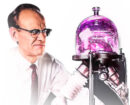There is a great story running this week in an online publication called The Epoch Times. The feature offers a pretty balanced perspective on the history of the Fusor, the work that has been done over the past decade-plus, and the realistic prospects for ever achieving useful (i.e. "breakeven") energy from a fusion process.
One important note, though. The article cites this anecdote, which I shared with the author, regarding the manner in which Farnsworth discontinued his fusion work:
After inventing the television in the 1920s, Farnsworth was ready to change the face of society once again. Just as he managed to get his machine to achieve the impossible, his son peeked into the bizarre laboratory. Suddenly a thought struck him, causing Farnsworth to dismantle his machine. He placed it onto a shelf where it could not be reached and never worked on it again.
Farnsworth had a struggle with himself “for several years over what was going to happen to culture and society if we suddenly had virtually unlimited resources of energy at our disposal,” said Paul Schatzkin, 60, who relayed the story of Farnsworth.
That is not, strictly speaking, a "true" story. It is, rather, an apocryphal accounting, an artifact from the very first time I ever heard about Philo T. Farnsworth and his fusion work.
The occasion was in the summer of 1973. I had just moved from the east coast to California after graduating from college (well, sorta…), and with a friend made a road trip from LA up to the Bay area. I had only first heard of Philo T. Farnsworth a few months earlier in the "Videocity" edition of a publication called "Radical Software," which brought the anarchistic hippie sensibilities of the 1960s to the guerilla video (the "new media" of its day) of the 1970s.
I'd experimented with the very earliest portable video systems in college, and Radical Software was the bible of that movement. The "Videocity" edition was so-named because it was edited out of San Francisco, the city where, I learned for the first time, video in its electronic form had made its first appearance in 1927 on Philo Farnsworth's workbench.
Long story made short, during that trip up to Santa Cruz, my friend and I dropped in on a fellow video activist who styled himself as "Johnny Videotape" and ran the Santa Cruz Public Access Community Television Service behind that moniker. "Johnny" (I have no recollection now what his real name was…) was friends with a fellow named Phil Geitzen, who edited that "Videocity" edition of Radical Software, and Phil Geitzen, in turn, was a friend of Philo T. Farnsworth III – the eldest son of The Boy Who Invented Television.
The story that is cited above is a story that Johnny Videotape told me, which is his retelling of the story that Phil Geitzen told him, which is thus some variation of a story that originated with Philo T. Farnsworth III.
Little did I know at the time that a couple of years later, I would meet Philo T. Farnsworth III myself, that he would be come a dear friend, and that the Farnsworth family and story would become an integral part of my life for years to come.
When I met Philo III (aka "P3") in the summer of 1975, one of my first questions to him was to ask for some corroboration of the story I'd heard from Johnny Videotape. He explained in very sanguine terms that while the specific story was not true, the essence of it is: he had been present during many of his father's experiments with fusion in the early 1960s, and held the conviction that once his father could see a path from his experiments to some realization of his work (in theory, at least), he then made a conscious decision to stop. He did, in effect, shelve his own work.
Whether or not there is, indeed, any path from Farnsworth's work to a practical source of fusion-generated energy will be debated until either that path is found or an entirely different approach proves viable and puts the Fusor, once and for all, on the shelf of scientific footnotes.
Until then, the work continues, and the Fusioneers blaze the trail.
